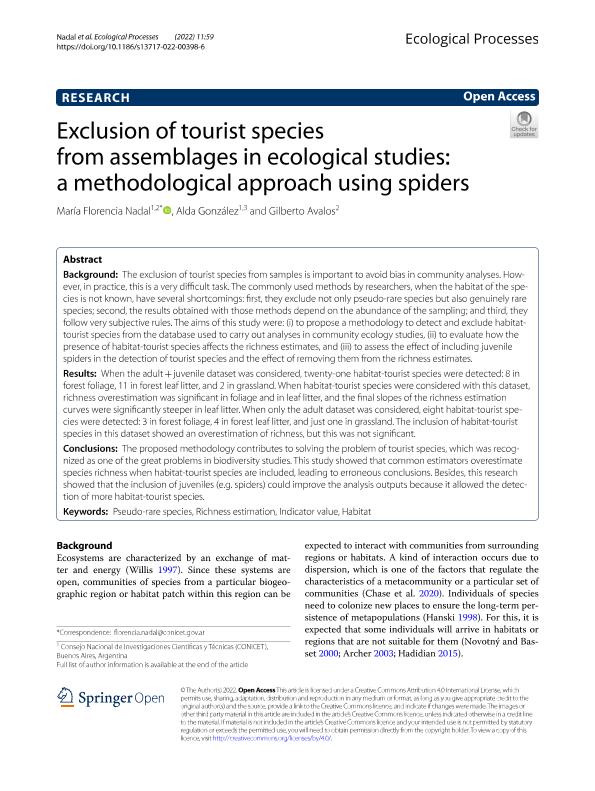Artículo
Exclusion of tourist species from assemblages in ecological studies: a methodological approach using spiders
Fecha de publicación:
12/2022
Editorial:
Springer
Revista:
Ecological Processes
e-ISSN:
2192-1709
Idioma:
Inglés
Tipo de recurso:
Artículo publicado
Clasificación temática:
Resumen
Background: The exclusion of tourist species from samples is important to avoid bias in community analyses. However, in practice, this is a very difficult task. The commonly used methods by researchers, when the habitat of the species is not known, have several shortcomings: first, they exclude not only pseudo-rare species but also genuinely rare species; second, the results obtained with those methods depend on the abundance of the sampling; and third, they follow very subjective rules. The aims of this study were: (i) to propose a methodology to detect and exclude habitat-tourist species from the database used to carry out analyses in community ecology studies, (ii) to evaluate how the presence of habitat-tourist species affects the richness estimates, and (iii) to assess the effect of including juvenile spiders in the detection of tourist species and the effect of removing them from the richness estimates. Results: When the adult + juvenile dataset was considered, twenty-one habitat-tourist species were detected: 8 in forest foliage, 11 in forest leaf litter, and 2 in grassland. When habitat-tourist species were considered with this dataset, richness overestimation was significant in foliage and in leaf litter, and the final slopes of the richness estimation curves were significantly steeper in leaf litter. When only the adult dataset was considered, eight habitat-tourist species were detected: 3 in forest foliage, 4 in forest leaf litter, and just one in grassland. The inclusion of habitat-tourist species in this dataset showed an overestimation of richness, but this was not significant. Conclusions: The proposed methodology contributes to solving the problem of tourist species, which was recognized as one of the great problems in biodiversity studies. This study showed that common estimators overestimate species richness when habitat-tourist species are included, leading to erroneous conclusions. Besides, this research showed that the inclusion of juveniles (e.g. spiders) could improve the analysis outputs because it allowed the detection of more habitat-tourist species.
Palabras clave:
HABITAT
,
INDICATOR VALUE
,
PSEUDO-RARE SPECIES
,
RICHNESS ESTIMATION
Archivos asociados
Licencia
Identificadores
Colecciones
Articulos(CCT - NORDESTE)
Articulos de CTRO.CIENTIFICO TECNOL.CONICET - NORDESTE
Articulos de CTRO.CIENTIFICO TECNOL.CONICET - NORDESTE
Articulos(CEPAVE)
Articulos de CENTRO DE EST.PARASITOL.Y DE VECTORES (I)
Articulos de CENTRO DE EST.PARASITOL.Y DE VECTORES (I)
Citación
Nadal, María Florencia; Gonzalez, Alda; Avalos, Gilberto; Exclusion of tourist species from assemblages in ecological studies: a methodological approach using spiders; Springer; Ecological Processes; 11; 1; 12-2022; 1-20
Compartir
Altmétricas




